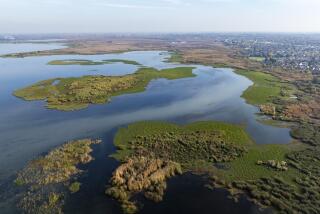Editorial: California needs a workable delta tunnel plan
Like a patient waiting for heart bypass surgery while the insurance company dickers with the hospital over the numbers, California has been stuck in pre-op for decades, awaiting approval of an aqueduct or tunnel bypass from the Sacramento River around (instead of through) the state’s hydrological heart — the Sacramento-San Joaquin River Delta.
The $17-billion proposal to build twin tunnels stalled again last year when several large water agencies withheld their financial support. Now the state Department of Water Resources is proposing to build the project in stages, starting with just a single tunnel at a cost of $10.7 billion. Half the size, half the cost, half the trouble? If only.
It’s pretty much the same project it was before, with all the same controversies. The Times supported the larger project, notwithstanding lingering questions about possible new environmental consequences. The staged project might merit support as well, at least in theory, pending more analysis on how much of the cost would be passed along to Southern Californians through their primary water wholesaler, the Metropolitan Water District, and pending further analysis of the environmental impact in the delta.
A major goal of the project — whether it’s one tunnel or two — is to alleviate hazards at the delta’s south end, caused when the powerful pumps that lift water for its journey to Central and Southern California reverse the flow of the lower San Joaquin River and draw endangered fish from their migratory paths. Tunnels located farther to the north, drawing in water by gravity rather than by pumps, could improve the situation if they are used to divert water only when there is enough flowing through the delta to sustain the salmon and other species passing through it.
But many environmentalists and delta advocates have very little faith that any tunnel would be operated so responsibly.
There is not much of a path forward without a measure of trust. And between the north and the south, agribusiness and urban areas, environmentalists and water districts, federal and state water contractors, taxpayers and ratepayers, trust is even less evident than this winter’s rains.
That leaves California still lying on the table, waiting for some kind of fix that will keep the delta ecosystem from collapsing while providing as steady a supply of water as possible to San Joaquin Valley agricultural fields and Los Angeles faucets, amid the shrinking Sierra snowpack and a more volatile and less predictable winter storm pattern.
Delta deliveries are not only an essential component of Los Angeles’ water supply mix, they are virtually the only source for some communities between here and the Bay Area. It’s an exercise in self-deception to believe that Southern California can generate 100% of its own water supply and need not shore up the import system that was created in the last century.
And yet, as plans for the delta drag on, the region must keep moving forward on its local water-capture and recycling efforts. That’s because all those sources of imported water, as much as they are needed, will never again supply as much as they once did. The Los Angeles Aqueduct that brings water from the Owens Valley to the city of L.A. is a priceless treasure, but so are Mono Lake and the Eastern Sierra, and in dry winters like this one — as opposed to over-abundant snow seasons like last year’s — the city must reduce imports to settle lawsuits over preserving those regions. L.A. and the rest of Southern California also rely on the Colorado River, but we have gotten too used to over-drawing its water because other Western cities didn’t need their full allocations. Those days are gone. And besides, drought plagues the Rockies as well as the Sierras.
It’s an exercise in self-deception to believe that Southern California can generate 100% of its own water supply.
There are other rivers to tap, if we expand our definition of “river.” One is the river of wastewater this region sends daily into the ocean. Another is the river of stormwater that flows to the sea as well during those few winter storms that still come our way, even if they have been scarcer this year. Those two sources require a 21st century approach to engineering — fewer aqueducts, shorter distances, more intensive cleansing and better use of underground storage. Southern Californians will have to pay for that, and money, like water, has its limits. Perhaps we should pay for the delta tunnel too — but only if the price is fair and the product yields both a reasonably reliable water supply and a delta environment that is protected rather than degraded.
Follow the Opinion section on Twitter @latimesopinion and Facebook
More to Read
A cure for the common opinion
Get thought-provoking perspectives with our weekly newsletter.
You may occasionally receive promotional content from the Los Angeles Times.






